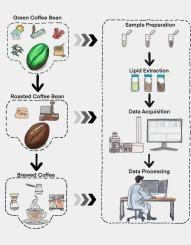从绿豆到煮咖啡:咖啡脂质组成的脂质组学观点
IF 9.8
1区 农林科学
Q1 CHEMISTRY, APPLIED
引用次数: 0
摘要
咖啡是全球消费最多的五种饮料之一。脂质是咖啡的感官特性的关键因素。生咖啡豆、烘焙咖啡豆和煮咖啡的脂质含量和组成不同。尽管脂质含量已经得到了很好的研究,但由于传统的咖啡脂质分析方法耗时,脂质成分数据仍然主要局限于青豆,这使得很难追踪从农场到杯子的脂质变化。LC-MS/MS仪器的最新进展使我们能够通过快速脂质组学分析来了解整个咖啡脂质组。然而,最近的一些脂质组学研究并没有报道众所周知的咖啡脂质(如二萜酯),可能是由于脂质搜索使用的数据库。这篇综述讨论了目前脂质组学方法的局限性,旨在改进这种分析方法,以了解咖啡生产各个阶段脂质组成的变化。本文章由计算机程序翻译,如有差异,请以英文原文为准。

From green bean to brewed coffee: A Lipidomic perspective on coffee lipid composition
Coffee ranks among the top five beverages consumed worldwide. Lipids are a key contributor to coffee's organoleptic properties. Lipid content and composition differ between green coffee beans, roasted coffee beans and brewed coffee. Although the lipid content has been well studied, lipid compositional data remain limited mainly to green beans due to the time-consuming conventional method for coffee lipid analysis, making it difficult to trace how lipids change from farm to cup. Recent advances in LC-MS/MS instruments enable the understanding of the whole coffee lipidome by a fast lipidomic analysis. However, some recent lipidomic studies have not reported well-known coffee lipids (e.g. diterpene esters), possibly due to the databases used for lipid search. This review discusses the limitations of the current lipidomic approach and aims to improve this analytical method to understand the changes in lipid composition across various stages of coffee production.
求助全文
通过发布文献求助,成功后即可免费获取论文全文。
去求助
来源期刊

Food Chemistry
工程技术-食品科技
CiteScore
16.30
自引率
10.20%
发文量
3130
审稿时长
122 days
期刊介绍:
Food Chemistry publishes original research papers dealing with the advancement of the chemistry and biochemistry of foods or the analytical methods/ approach used. All papers should focus on the novelty of the research carried out.
 求助内容:
求助内容: 应助结果提醒方式:
应助结果提醒方式:


